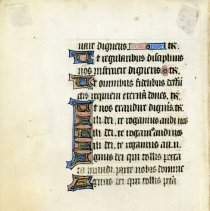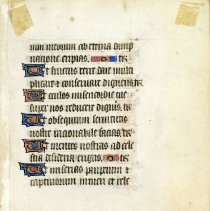Object Record
Images


Metadata
Catalog Number |
1966.034 |
Object Name |
Leaf |
Description |
This is a leaf from a late medieval/early Renaissance illuminated manuscript, specifically a special notice of St. Martin of Tours in Calendosa from a book of hours. The leaf is a single page with two sides, upon each of which are twelve lines of Latin in blackletter Gothic script. The first letter of each individual sentence is illuminated with blue and red paint and gold-leaf lettering as well as occasional decorative illumination within the lines. The leaf dates to circa 1440, and is from a region in the north of France, likely the city of Tours. The leaf consists of a recto and verso (front and back) with minimal illumination and Latin calligraphy in the Blackletter style; the lettering is in the style of northern French Textualis from the 15th century, characterized by a laterally compressed and angular script. The contents of the leaf consist of part of a common prayer known as the Litany of the Saints. The Catholic Encyclopedia states that the origin of this form of prayer traces its origins back to the early church, with providence being associated with St. Gregory the Great and his Litania Septiformis. The following is the Latin script transcribed from both sides of the leaf; Recto -rum meorum ab eterna dam nacione eripias tr Ut fructus terre dare multi -plicare et conservare digneris tr Ut oculos misericordiae tuae Super nos reducere digneris tr Ut obsequium servitutis nostre racionabile facias tr Ut mentes nostras ad cele -stia desideria erigas tr Ut miserias pauperum sic Captivorum intueri et rele Verso -vare digneris tr Ut regularibus disciplinis nos instruere digneris tr Ut omnibus fidelibus defun -ctis requiem eterna dones tr Ut nos exaudire digneris tr Filii dei, te rogamus audi nos Filii dei, te rogamus audi nos Filii dei, te rogamus audi nos Agnus dei qui tollis pecca -ta mundi parce nobis domine Agnus dei qui tollis peccata Below is a translation of the prayer into English. Recto Rescue _ of my _ from eternal damnation, we beseech you. That you would deign to grant, preserve and multiply the fruits of the earth, we beseech you. That you would deign to turn your merciful eyes upon us, we beseech you. That you would deign to make reasonable the obedience of our worship, we beseech you. That you would deign to raise our minds to heavenly desires, we beseech you. That you would deign to look upon and, in this manner, relieve the misfortunes of the poor captives, we beseech you. Verso That you would deign to instruct us in canonical teachings, we beseech you That you may grant to all the dead eternal respose, we beseech you. That you would deign to hear us, we beseech you. Son of God, we beseech you, hear us. Son of God, we beseech you, hear us. Son of God, we beseech you, hear us. Lamb of God, who takes away the sins of the world, spare us O Lord. Lamb of God, who takes away - The Litany of Saints is a type of Catholic litany comprised of prayers to God, invocations for the intercessions of various Saints, typically including the Virgin Mary and the Archangels, the Patriarchs and Prophets, the Apostles and Evangelists, the martyrs, bishops and doctors of the church, priestly and male religious saints, and female saints (excluding the Virgin) in that order of hierarchy, and furthermore in chronological order to their respective hierarchy. The litany traditionally continues with a list of petitions, of which this particular leaf contains part of, and closes with further invocation to Christ, the beginning of which is also contained within the verso of this leaf. While this particular litany had been originally located within a book of hours, the Litany of the Saints is employed as a prayer in many important rituals within Christianity, such as the Easter Vigil, ordinations, infant baptism, for Rogation Days prior to the 20th century and various other ceremonial functions. The Book of Hours has its origin within the psalter; a book of psalms with attached prayer offices. These offices were separated from the psalter and formed the book of hours during the 13th century. Books of hours were typically written in Latin, sometimes with vernacular language included. Prior to the advent of printing, books of hours were composed as manuscripts and were individual commissions. Initially the majority of commissions came from the higher echelons of the medieval social elite, however in the 15th century, books of hours with less sumptuous illumination became more commonplace among the middle class. As the book of hours became more accessible to the lower nobility and bourgeoisie, the book trade established itself as a profitable industry in which booksellers, scribes and illuminators made livings for themselves in small workshops clustered in neighborhoods around universities or cathedrals in cities across France. The shop-copy books of hours vastly differed from luxury books in both content and construction, lacking the extensive care and attention paid by the Limbourg brothers in books like Tres Riches Heures de Duc de Berry, but this did not make them any less significant in their personal value and these objects were deeply treasured by the people who owned them. St. Martin of Tours was born in Sabaria, Pannonia (Szombathely, Hungary), either in 316 AD or 336 AD depending on the chronology, growing up in Ticinum (Pavia, Italy) as the son of a Roman tribune. St. Martin served within the Roman military by the time he was fifteen, stationed in the Roman province of Gaul. During this time, he was moved to quit his military service by a vision of Christ appearing to him in a dream, which led him to become a follower of St. Hilary of Poitiers. St. Martin was elected by the people of Tours to serve as bishop, where he established the monastery of Marmoutier and established parish churches during his tenure as bishop. St. Martin died on November 8, 397. St. Martin of Tours is the patron saint of beggars, the Salian and Merovingian Franks, and the Third French Republic, and is typically depicted in iconography as a man on horseback sharing his cloak with a beggar, or a man cutting his cloak in half. These attributes can be traced to Sulpicius Severus' Life of St. Martin, in which there is contained an account of the Saint cutting his cloak into two to clothe a beggar. The half of the cloak retained by St. Martin is said to have been preserved as a relic at the Marmoutier Abbey. It was held by the kings of France as an important religious artifact in the cultus of St. Martin. Special thanks to Dr. Brian J. Maxson, Mrs. Deanne Toye, and Seth Luccas for assistance with the transcription and translation of the leaf. The sources used to complete this research can be made available upon request. |
Date |
c. 1440 |
Collection |
Pre-1900 Art Collection |
Place of Origin |
Europe/France |
Material |
paper, ink, gold leaf |
Subjects |
European Art International Art Art History |
Other Name |
Illuminated Manuscript Leaf |
Search Terms |
sacred religion European Art International Art Art History |
